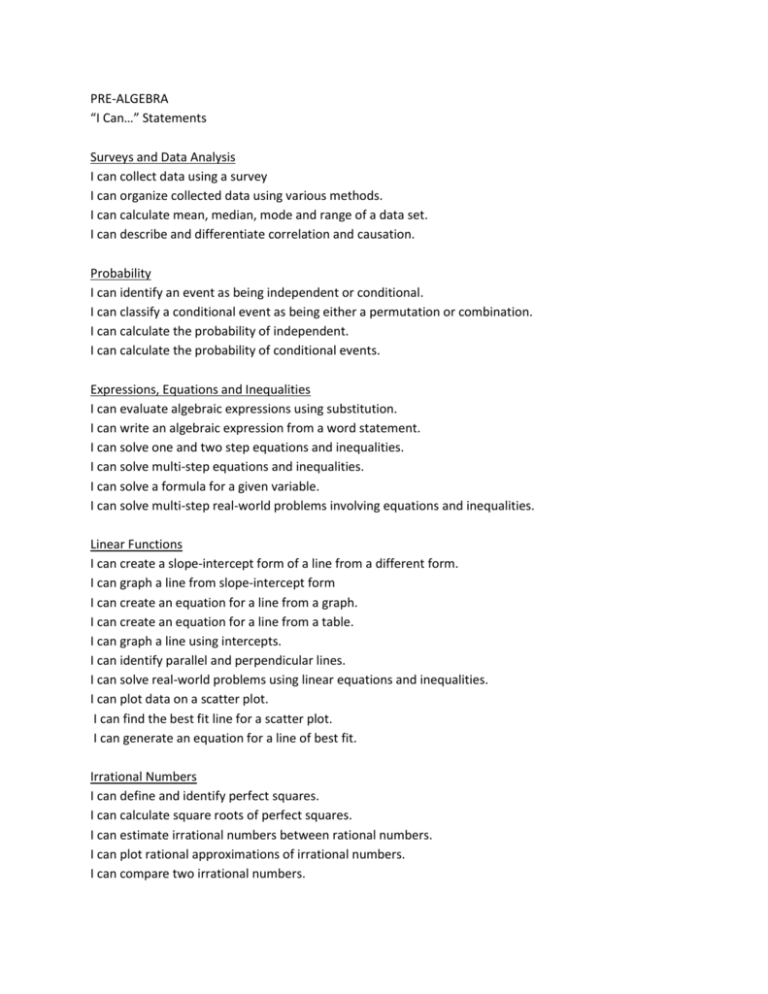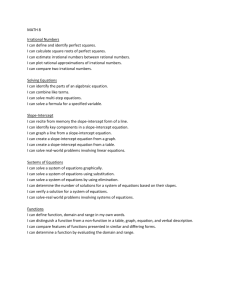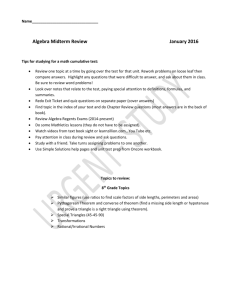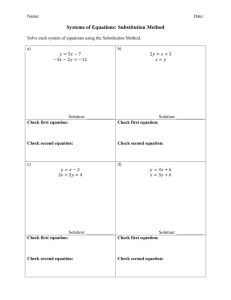I Can…” Statements
advertisement

PRE-ALGEBRA “I Can…” Statements Surveys and Data Analysis I can collect data using a survey I can organize collected data using various methods. I can calculate mean, median, mode and range of a data set. I can describe and differentiate correlation and causation. Probability I can identify an event as being independent or conditional. I can classify a conditional event as being either a permutation or combination. I can calculate the probability of independent. I can calculate the probability of conditional events. Expressions, Equations and Inequalities I can evaluate algebraic expressions using substitution. I can write an algebraic expression from a word statement. I can solve one and two step equations and inequalities. I can solve multi-step equations and inequalities. I can solve a formula for a given variable. I can solve multi-step real-world problems involving equations and inequalities. Linear Functions I can create a slope-intercept form of a line from a different form. I can graph a line from slope-intercept form I can create an equation for a line from a graph. I can create an equation for a line from a table. I can graph a line using intercepts. I can identify parallel and perpendicular lines. I can solve real-world problems using linear equations and inequalities. I can plot data on a scatter plot. I can find the best fit line for a scatter plot. I can generate an equation for a line of best fit. Irrational Numbers I can define and identify perfect squares. I can calculate square roots of perfect squares. I can estimate irrational numbers between rational numbers. I can plot rational approximations of irrational numbers. I can compare two irrational numbers. Exponents I can apply the exponent properties to simplify exponent expressions. I can solve real-world problems involving squared and cubed variables. I can perform operations of two numbers written in scientific notation. I can perform operation of a decimal and a number in scientific notation. Pythagorean Theorem I can recite the Pythagorean Theorem and identify its components on a triangle. I can explain the principles of the Pythagorean Theorem I can solve for the unknown hypotenuse of a right triangle. I can solve for the unknown leg of a right triangle. I can solve for any unknown part of a right triangle in a real-world problem. I can calculate the distance between two points using the Pythagorean Theorem. Functions I can define function, domain and range in my own words. I can distinguish a function from a non-function in a table, graph, equation, and verbal description. I can compare features of functions presented in similar and differing forms. I can determine a function by evaluating the domain and range. Systems of Equations I can solve a system of equations graphically. I can solve a system of equations using substitution. I can solve a system of equations by using elimination. I can determine the number of solutions for a system of equations based on their slopes. I can verify a solution for a system of equations. I can solve-real world problems involving systems of equations. Slope-Intercept I can recite from memory the slope-intercept form of a line. I can identify key components in a slope-intercept equation. I can graph a line from a slope-intercept equation. I can create a slope-intercept equation from a graph. I can create a slope-intercept equation from a table. I can solve real-world problems involving linear equations. Solve Equations I can identify the parts of an algebraic equation. I can combine like terms. I can solve multi-step equations. I can solve a formula for a specified variable.









